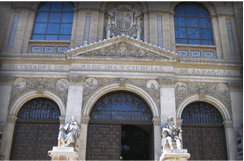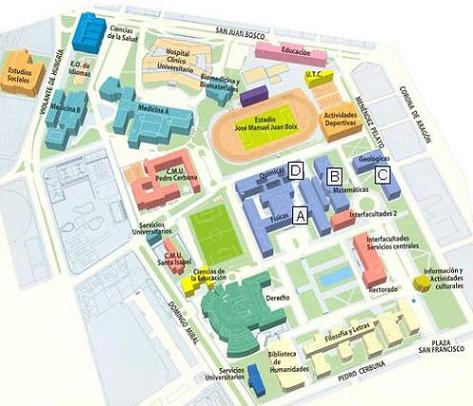The Faculty of Sciences

The Faculty of Science has a long history of excellence in teaching and research. The Faculty also has a strong international profile and attracts students from Europe and around the world. With more than 1,000 ISI journal articles published per year, the Faculty is a leading research hub at the University of Zaragoza, ranked among the top 200 world-class universities for natural sciences and mathematics (ARWU 2016).
Location
Our Faculty is located at the centre of Zaragoza in the San Francisco campus. There are four main buildings: A (Secretarial staff and Physics), B (Mathematics and Statistics), C (Geology) and D (Chemistry).
|
|
Buildings
|
Facilities
- Classrooms and other available rooms that can be booked
- Computer rooms and information about their available equipment and software
- Analytical Chemistry Tel. 976761290 Fax 976761292
- Anatomy, Embryology and Animal Genetics Tel. 976761604 Fax 976761605
- Animal Production and Food Sciences Tel. 976762132 Fax 976761590
- Applied Mathematics Tel. 976761124 Fax 976761125
- Applied Physics Tel. 976761232 Fax 976761233
- Biochemistry and Molecular and Cellular Biology Tel. 976761287 Fax 976762123
- Business Organisation and Management Tel. 976762097 Fax 976761835
- Chemical Engineering and Environmental Technology Tel. 976761154 Fax 976762142
- Computing and Systems Engineering Tel. 976761948
- Condensed Matter Physics Tel. 976761230 Fax 976761229
- Design and Fabrication Engineering Tel. 976761900 Fax 976762235
- Documentation Science and History of Science Tel. 976763828 Fax 976762305
- Earth Sciences Tel. 976761105 Fax 976761106
- Economic Analysis Tel. 976761831 Fax 976761996
- Electrical Engineering and Communications Tel. 976762143 Fax 976762111
- English and German Studies Tel. 976761538 Fax 976761519
- French Studies Tel. 976761537 Fax 976761534
- Geography and Territorial Planning Tel. 976762060 Fax 976761506
- History of Science (Area) Tel. 976761119 Fax 976761125
- Human Anatomy and Histology Tel. 976761667 Fax 976761754
- Inorganic Chemistry Tel. 976761188 Fax 976761187
- Marketing Management and Market Research Tel. 976762679 Fax 976761767
- Mathematics Tel. 976761111 Fax 976761338
- Mechanical Engineering Tel. 976761913 Fax 976762670
- Medicine, Psychiatry and Dermatology Tel. 976761715 Fax 976761712
- Microbiology, Preventive Medicine and Public Health Tel. 976761691 Fax 976761693
- Organic Chemistry Tel. 976761203 Fax 976761202
- Pathological Anatomy, Legal Medicine, Toxicology and Health Legislation Tel. 976761733 Fax 976762070
- Pharmacology and Physiology Tel. 976761699 Fax 976761700
- Physical Chemistry Tel. 976761203 Fax 976761202
- Private Law Tel. 976761468 Fax 976762850
- Public Law Tel. 976761433 Fax 976761499
- Science and Technology of Materials and Fluids Tel. 976761958 Fax 9767761957
- Statistical Methods Tel. 976761116 Fax 976761115
- Surgery, Gynaecology and Obstetrics Tel. 976761734 Fax 976761735
- Teaching Experimental Science Tel. 976761302 Fax 976762071
- Theoretical Physics Tel. 976761262 Fax 976761264
Administrative structure
- Dean's Team
- Faculty Board
- Grades Coordinators
- Official Postgraduate Programmes Coordinators
- Permanent Committee of the Faculty Board
- Teaching Committee
- Assessment and Teaching Management Committee
- Delegated Committee for Health and Safety
- Work Experience Coordinators
- Quality Assessment Committees
A brief history
 |
The Faculty of Sciences as we understand it today had its origins in the second half of the nineteenth century - although it had been previously possible to study Mathematics, Chemistry and Natural Science in schools organized by popular initiatives such as the Aragonese Economic Society and the Zaragoza City Council. However, in 1868-1869, new legal frameworks established the context for a baccalaureate in science after two years of study common to each discipline, followed by a Degree course with two or three additional years of specialization leading to a Degree in the relevant subject. In the first year of these new courses, a provisional 'Faculty of Sciences' in effect emerged. During this first phase, Bruno Solano and Zoel Garcia de Galdeano, who later became lecturers themselves were pupils at the faculty. |
Despite this progress, new legislation closed the Faculty of Sciences in 1874. Thanks to the efforts of the academic staff, the City Council and a ministerial change, the faculty was reopened in September 1893 with new sections including Physical Chemistry and Physical Mathematics - officially and definitively constituting the Faculty of Sciences of the University of Zaragoza.
|
In 1900, following new directives from the Ministry of Public Education, mixed sections disappeared and in 1903 separated sections in Chemistry and Mathematics were created, and the latter incorporation of Physics in 1913. In comparison with Faculties in Madrid and Barcelona, Natural Sciences studies were still missing. Many years were needed before a new expansion in studies took place and it was not until 1973 that degree courses in Geological Sciences were first offered. Later, in 1990, a diploma in Statistics was established and in 1998 a second cycle degree course in Biochemistry was included. |
 |
As can be seen, the development of the studies of the Faculty of Sciences has sometimes been difficult, as indeed has been the development of its facilities. The Faculty of Sciences was initially established in the old Magdalena building of the University. When expansion was needed in 1893, the Faculty was moved to the new Faculty of Sciences and Medicine building in the Plaza de Paraíso, designed by the architect Ricardo Magdalena y Tabuenca. Finally in 1962, the Faculty was moved to the new Faculty of Sciences building on the main Campus (or Ciudad Universitaria).
The implementation of new courses, the increase in the number of students and lecturers, the developing needs in teaching and research laboratories, as well as the urgent expansion of the existing buildings around an already crowded campus were the main developments. As a result, the initial building (Sciences-A now) housed Physics, Biochemistry, Optics and Optometry, the Sciences-B building, opened in 1982, Mathematics and Statistics, and the so-called Sciences-C building, opened in 1984, Geology. Most recently, Sciences-D building ,aimed at Chemistry, has been in use since 1999.
In the lecture halls of the Faculty of Sciences, many students that have subsequently become outstanding scientists, completed their studies and began their careers in the scientific world. In addition, the Faculty´s own academic staff have gained such wide professional recognition that it is not possible to detail all their achievements here.


